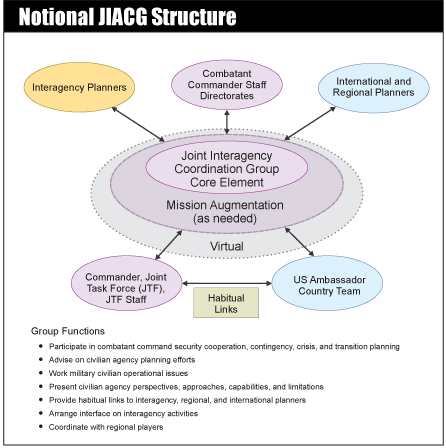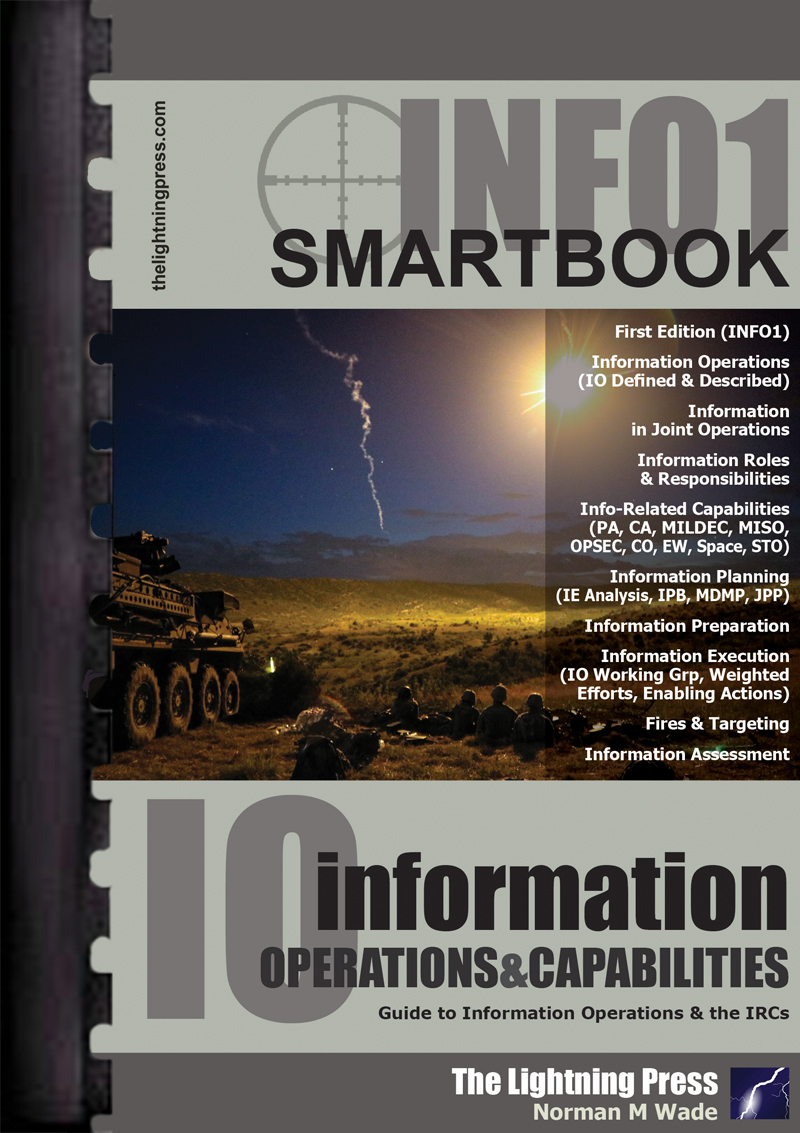A Joint Interagency Coordination Group (JIACG) is an interagency staff group that establishes regular, timely, and collaborative working relationships between civilian and military operational planners. Composed of USG civilian and military experts accredited to the Combatant Commander (CCDR) and tailored to meet the requirements of a supported combatant command, the JIACG (or equivalent organization) provides the CCDR with the capability to collaborate at the operational level with other USG civilian agencies and departments. One size does not fit all. Each combatant command has implemented and tailored their JIACG (or equivalent organization) based on their unique requirements, AORs, and missions to include titles and organizational schemes, to suit their needs (e.g., interagency partnering directorate, commander’s interagency engagement group, commander’s JIACG.)

Interagency coordination occurs between DOD and other USG departments and agencies, as well as with private-sector entities, nongovernmental organizations, and critical infrastructure activities, for the purpose of accomplishing national objectives. Many of these objectives require the combined and coordinated use of the diplomatic, informational, military, and economic instruments of national power. Due to their forward presence, the Combatant Commands (CCMDs) are well situated to coordinate activities with elements of the USG, regional organizations, foreign forces, and host nations. In order to accomplish this function, the GCCs have established JIACGs as part of their normal staff structures.
Faced with challenges to national interests, the United States, along with its multinational partners, can respond by using the capabilities resident in one or more of the instruments of national power (diplomatic, informational, military, and economic). A strategic, top-down approach aligns and harmonizes a variety of ways and means with a set of desired strategic ends. These ends provide the fundamental purpose and context for committing the military and other instruments of national power.
The Civil-Military Relationship
The crux of interorganizational coordination is in understanding the civil-military relationship as collaborative rather than competitive. The most productive way to look at this relationship is seeing the comparative advantages of each of the two communities—military and civilian. While the military normally focuses on reaching clearly defined and measurable objectives within given timelines under a C2 structure, civilian organizations are concerned with fulfilling changeable political, economic, social, and humanitarian interests using dialogue, bargaining, risk taking, and consensus building. Civilian organizations may have a better appreciation of the political-social¬cultural situation, and have better relief, development, and public administration. They may be more adept at negotiation, bargaining, and consensus decision making, thus potentially acting as agents of change within that society.
Interagency Coordination during Joint Planning
When campaign planning, deliberate planning, or crisis action planning (CAP) is required, the degree to which military and civilian components can be integrated and harmonized will bear directly on its efficiency and success. To the extent feasible, joint planning should include key participants from the outset. The CCDR, through his strategic concept, works with the engaged civilian organizations to build annex V (Interagency Coordination) of the joint operation plan. Subordinate JFCs also build civilian organization participation into their OPLAN, and increasingly, participate in integrated civil-military campaign planning with the embassy. Within the area of responsibility (AOR) and the joint operations area (JOA), appropriate decision-making structures are established at combatant command, joint task force (JTF) HQ, and tactical levels in order to coordinate and resolve military, political, humanitarian, and other issues.
Joint and multinational operations against contemporary adversaries or supporting civil authorities during catastrophic disasters require unified action in planning and execution with interagency and multinational partners who are not under US military command authority. This effort depends on building and sharing a common understanding of the strategic purpose and end state; developing relevant objectives; a common understanding of the operational environment; and harmonization of the actions required to resolve the problem.
Increased and efficient organizational cooperation between and among the myriad organizations performing their roles to achieve national strategic objectives is essential. Challenges to effective interagency coordination caused by partners having conflicting policies and procedures further complicates efforts at achieving unity of effort. Typically, each agency develops its own agency-specific plans at varying levels of detail in response to an issue or event. The challenge to the interagency community is to take single agency planning efforts and meld them into a collaborative, multiagency planning process that exploits the core competencies of all the interagency partners.
Joint Task Forces in the Interagency Process
When it is necessary to engage the military instrument of national power, and to establish a JTF, the establishing authority is normally a CCDR. The CCDR develops the mission statement and CONOPS based upon direction from SecDef as communicated through the CJCS. If developed, the NSC’s interagency plan may affect the mission statement. The CCDR appoints a commander, joint task force (CJTF), and, in conjunction with the CJTF, determines the necessary military capabilities required to accomplish military objectives. A CJTF has the authority to organize forces and the JTF HQ as necessary to accomplish the objectives.
Unlike the military, most USG agencies are not equipped and organized to create separate staffs at the strategic, operational, and tactical levels, with the result that JTF personnel interface with individuals who are coordinating their organization’s activities at more than one level. The USG interagency process requires the JTF HQ to be especially flexible, responsive, and cognizant of the capabilities of USG agencies, IGOs, the HN, and NGOs. The JTF HQ provides an important basis for a unified effort, centralized planning and direction, and decentralized execution. Depending on the type of operation, the extent of military operations, and degree of interagency, IGO, and NGO involvement, the focal point for operational-and tactical-level coordination with civilian agencies may occur at the JTF HQ, the joint field office (JFO), the CMOC, or the humanitarian operations center (HOC). JTF personnel may also participate actively or as observers in a civilian-led functional coordinating group, concentrating on a specific issue or project.
 This article is an extract from "JFODS6: The Joint Forces Operations & Doctrine SMARTbook, 6th Ed. (Guide to Joint Warfighting, Operations & Planning)" by The Lightning Press. Download a free PDF sample and learn more at: JFODS6: The Joint Forces Operations & Doctrine SMARTbook, 6th Ed. (Guide to Joint Warfighting, Operations & Planning).
This article is an extract from "JFODS6: The Joint Forces Operations & Doctrine SMARTbook, 6th Ed. (Guide to Joint Warfighting, Operations & Planning)" by The Lightning Press. Download a free PDF sample and learn more at: JFODS6: The Joint Forces Operations & Doctrine SMARTbook, 6th Ed. (Guide to Joint Warfighting, Operations & Planning).
Browse additional military doctrine articles in our SMARTnews Blog & Resource Center.
About The Lightning Press SMARTbooks. Recognized as a “whole of government” doctrinal reference standard by military, national security and government professionals around the world, SMARTbooks comprise a comprehensive professional library. SMARTbooks can be used as quick reference guides during operations, as study guides at education and professional development courses, and as lesson plans and checklists in support of training. Browse our collection of Military Reference SMARTbooks to learn more.











































